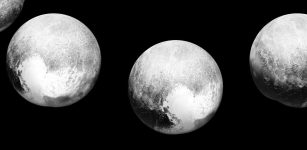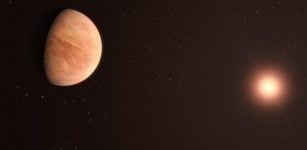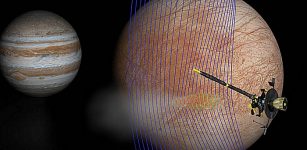First Calculations Of Magnetic Activity In ‘Hot Jupiter’ Exoplanets
Eddie Gonzales Jr. – MessageToEagle.com – For the first time, astronomers calculated the strength of powerful magnetic fields, one of the important characteristics of gas-giant planets orbiting close to other stars.
“Our study is the first to use observed signals to derive exoplanet magnetic field strengths,” associate professor Evgenya Shkolnik of Arizona State University’s School of Earth and Space Exploration, said in a press release.
“These signals appear to come from interactions between the magnetic fields of the star and the tightly orbiting planet.”
Previous studies have placed upper limits on exoplanet magnetic fields, for example from radio observations or derived purely from theory.
“We combined measurements of increased stellar emission from the magnetic star-planet interactions together with physics theory to calculate the magnetic field strengths for four hot Jupiters,” says lead author Wilson Cauley of the University of Colorado.
The magnetic field strengths the team found range from 20 to 120?gauss. For comparison, Jupiter’s magnetic field is 4.3 gauss and Earth’s field strength is only half a gauss, although that is strong enough to orient compasses worldwide.
The astrophysicists used telescopes in Hawaii and France to acquire high-resolution observations of emission from ionized calcium (Ca II) in the parent stars of the four hot Jupiters. The emission comes from a star’s hot, magnetically heated chromosphere, a thin layer of gas above the cooler stellar surface. The observations let the team calculate how much energy was being released in the stars’ calcium emission.
“We used the power estimates to calculate magnetic field strengths for the planets using a theory for how the planets’ magnetic fields interact with the stellar magnetic fields,” Shkolnik said.
Cauley explains that magnetic fields like to be in a state of low energy. If you twist or stretch the field like a rubber band, this increases the energy stored in the magnetic field.” Hot Jupiters orbit very close to their parent stars and so the planet’s magnetic field can twist and stretch the star’s magnetic field. When this happens, energy can be released as the two fields reconnect, and this heats the star’s atmosphere, increasing the calcium emission.”
Astrophysicists have suspected that hot Jupiters would, like our own Jupiter, have magnetic fields produced deep inside them. The new observations provide the first probe of the internal dynamics of these massive planets.
“This is the first estimate of the magnetic field strengths for these planets based on observations, so it’s a huge jump in our knowledge. It’s giving us a better understanding of what is happening inside these planets,” Shkolnik said.
“We knew nothing about their magnetic fields — or any other exoplanet magnetic fields — and now we have estimates for four actual systems.”
The observations support the idea that planetary magnetic fields depend on the amount of heat moving through the planet’s interior. Because they are absorbing a lot of extra energy from their host stars, hot Jupiters should have larger magnetic fields than planets of similar mass and rotation rate.
“We are pleased to see how well the magnitude of the field values corresponded to those predicted by the internal heat flux theory,” says Shkolnik. “This may also help us work toward a clearer understanding of magnetic fields around temperate rocky planets.”
Written by Eddie Gonzales Jr. – MessageToEagle.com Staff











